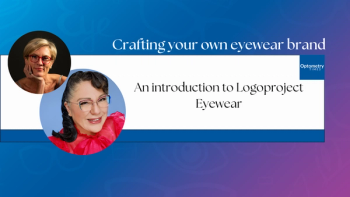
- May/June digital edition 2025
- Volume 17
- Issue 03
Atropine vs spectacles: Which move will be more powerful in the game of myopia management?

An official approval by the FDA in the United States can boost adoption rate of atropine and antimyopia glasses, which will change the landscape of myopia management.
Considering the rising prevalence of myopia around the world and in the United States,1 the optometric community will need all the tools available. The global projections on myopia prevalence, with a possible 50% of people with myopia by 2050,2 are alarming but not disastrous when all the possible treatment options are considered. Among treatment options already in markets other than the US, antimyopia glasses have a considerable potential for disruption. Despite being available as an off-label option, atropine treatment can also benefit from an official approval to a lesser extent. Every product has a life cycle of introduction. In the innovation adoption curve, myopia management is still in its early cycle as we move through the early adopter phase. The market will need more options than orthokeratology and soft contact lenses to move through the majority phases. An official approval by the FDA in the United States can boost that adoption rate and change the landscape of myopia management. To understand these changes and implications, we can look at the Canadian experience with antimyopia glasses that arrived on the market in the spring of 2020. Moreover, combined with the soft lens multifocal, Canada, like Australia, has been at the forefront of myopia control and management. Their experience can provide valuable insights into what the US optometric community can expect.
The Canadian experience with antimyopia glasses
The first lenses to control myopia, the Defocus Incorporated Multiple Segments lenses from HOYA, were launched in the spring of 2020. This technology consists of multiple +3.50-D honeycomb-shaped zones alternating with far vision power in the peripheral portion of the lens, with a clear central zone of 9 mm.3 The peripheral addition zone represents 50% of the area to bring the peripheral ray of light in front of the retina. The second technology available at the beginning of 2022 was Stellest by EssilorLuxottica, a constellation of peripheral aspheric lenses with varying addition power surrounded by the far vision power. The lens presents a central zone of 9 mm and a peripheral addition area ratio of 40%. This technology is based on the peripheral defocus mechanism.4 The third technology available was diffusion optics technology (DOT). This technology prevents myopia progression by diminishing the contrast through the lens instead of adding peripheral contrast.5 The DOT is labelled MiSight ophthalmic lenses in Canada. The last technology that merits mention is the lens launched by ZEISS, the MyoCare, which consists of cylindrical peripheral additions surrounded by the far vision power available in 2 different designs with a 7-mm or a 9-mm clear central zone. The peripheral ratio of addition is 50%, and the technology is called cylindrical annular refractive element technology. The Table3,4,6-19 summarizes the ophthalmic lenses available compared with the previous options. There are many more designs in the Canadian market, but only those presenting data with a control group are presented.
The introduction of antimyopia glasses has been a game changer in the market. On the optometric practice level, the first tangible impact was an increased demand for myopia management services of all sorts. The availability of glasses has increased the demand for myopia control because many parents judge that their children are not ready to wear contact lenses because they are too young. The transition to include ophthalmic lenses in the comprehensive myopia management programs had been straightforward. By monitoring more patients regularly and making more follow-up appointments to assess the effectiveness, the new option has enhanced patient and parent education about the pertinence of myopia control on long-term ocular health. This step necessitates more time initially but creates awareness that translates to an openness to graduate more patients into soft contact lenses or orthokeratology. With an increased level of knowledge about the effects of myopia on ocular health, parents are more exigent and proactive when it is time to switch treatment. In other words, when you educate about myopia control, parents are seeking absolute stability.
Moreover, the arrival of antimyopia glasses is an opportunity to create a network of references from schools or pediatricians with a first-tier option that does not have any major adverse effects. Each time a new product is on the market, it is an opportunity to talk more about the different options already available. On the clinical side, the glasses have made it possible for more clinics to buy an axial length–measuring device and enter the segment of myopia management.
If the FDA approves spectacles for myopia management, the US optometric community could experience similar changes and benefits as seen in Canada. It will immediately boost the adoption of myopia management. On the other hand, it will make more options available in terms of different point prices for the patient. We have to realize that scaling orthokeratology to include any patient with myopia is not possible on the clinical side and is not an option affordable for many families.
Atropine
Atropine is different. When you have a valid option with antimyopia glasses, practitioners do not use it as a first-line treatment. Even at low doses, most parents are concerned about the long-term effects of atropine. Atropine is an excellent add-on therapy for patients with an optical antimyopia device presenting with progression over the emmetropic value for the comparative age group. To become a serious treatment option, atropine will need to solve the dose problem that can vary from patient to patient. Moreover, the delivery mechanism needs to be improved to a point where the quantity of atropine reaching the retina is substantial. The other problem is the stability of the formulation over time. Atropine needs to be stable in the solution for longer than the actual formulation on the market. Finally, like every other drop, adherence is always a factor in the success of a treatment. In summary, the FDA’s approval of atropine will affect the market differently than the effects of antimyopia glasses.
References
1. Vitale S, Ellwein L, Cotch MF, Ferris FL 3rd, Sperduto R. Prevalence of refractive error in the United States, 1999-2004. Arch Ophthalmol. 2008;126(8):1111-1119. doi:10.1001/archopht.126.8.1111
2. Holden BA, Fricke TR, Wilson DA, et al. Global prevalence of myopia and high myopia and temporal trends from 2000 through 2050. Ophthalmology. 2016;123(5):1036-1042. doi:10.1016/j.ophtha.2016.01.006
3. Lam CSY, Tang WC, Tse DY, et al. Defocus Incorporated Multiple Segments (DIMS) spectacle lenses slow myopia progression: a 2-year randomised clinical trial. Br J Ophthalmol. 2020;104(3):363-368. doi:10.1136/bjophthalmol-2018-313739
4. Bao J, Huang Y, Li X, et al. Spectacle lenses with aspherical lenslets for myopia control vs single-vision spectacle lenses: a randomized clinical trial. JAMA Ophthalmol. 2022;140(5):472-478. doi:10.1001/jamaophthalmol.2022.0401
5. Laughton D, Hill JS, McParland M, et al. Control of myopia using diffusion optics spectacle lenses: four-year results of a multicentre randomised controlled, efficacy and safety study (CYPRESS). BMJ Open Ophthalmol. 2024;9(1):e001790. doi:10.1136/bmjophth-2024-001790
6. Rappon J, Chung C, Young G, et al. Control of myopia using diffusion optics spectacle lenses: twelve-month results of a randomised controlled, efficacy and safety study (CYPRESS). Br J Ophthalmol. 2023;107(11):1709-1715. doi:10.1136/bjo-2021-321005
7. Liu X, Wang P, Xie Z, et al. One-year myopia control efficacy of cylindrical annular refractive element spectacle lenses. Acta Ophthalmol. 2023;101(6):651-657. doi:10.1111/aos.15649
8. Cheng D, Woo GC, Drobe B, Schmid KL. Effect of bifocal and prismatic bifocal spectacles on myopia progression in children: three-year results of a randomized clinical trial. JAMA Ophthalmol. 2014;132(3):258-264. doi:10.1001/jamaophthalmol.2013.7623
9. Gwiazda J, Hyman L, Hussein M, et al. A randomized clinical trial of progressive addition lenses versus single vision lenses on the progression of myopia in children. Invest Ophthalmol Vis Sci. 2003;44(4):1492-1500. doi:10.1167/iovs.02-0816
10. Kanda H, Oshika T, Hiraoka T, et al. Effect of spectacle lenses designed to reduce relative peripheral hyperopia on myopia progression in Japanese children: a 2-year multicenter randomized controlled trial. Jpn J Ophthalmol. 2018;62(5):537-543. doi:10.1007/s10384-018-0616-3
11. Sankaridurg P, Donovan L, Varnas S, et al. Spectacle lenses designed to reduce progression of myopia: twelve-month results. Optom Vis Sci. 2010;87(9):631-641. doi:10.1097/OPX.0b013e3181ea19c7
12. Hasebe S, Jun J, Varnas SR. Myopia control with positively aspherized progressive addition lenses: a 2-year, multicenter, randomized, controlled trial. Invest Ophthalmol Vis Sci. 2014;55(11):7177-7188. doi:10.1167/iovs.12-11462
13. Hasebe S, Ohtsuki H, Nonaka T, et al. Effect of progressive addition lenses on myopia progression in Japanese children: a prospective, randomized, double-masked, crossover trial. Invest Ophthalmol Vis Sci. 2008;49(7):2781-2789. doi:10.1167/iovs.07-0385
14. Berntsen DA, Sinnott LT, Mutti DO, Zadnik K. A randomized trial using progressive addition lenses to evaluate theories of myopia progression in children with a high lag of accommodation. Invest Ophthalmol Vis Sci. 2012;53(2):640-649. doi:10.1167/iovs.11-7769
15. Chung K, Mohidin N, O’Leary DJ. Undercorrection of myopia enhances rather than inhibits myopia progression. Vision Res. 2002;42(22):2555-2559. doi:10.1016/s0042-6989(02)00258-4
16. Adler D, Millodot M. The possible effect of undercorrection on myopic progression in children. Clin Exp Optom. 2006;89(5):315-321. doi:10.1111/j.1444-0938.2006.00055.x
17. Logan NS, Wolffsohn JS. Role of un-correction, under-correction and over-correction of myopia as a strategy for slowing myopic progression. Clin Exp Optom. 2020;103(2):133-137. doi:10.1111/cxo.12978
18. Sun YY, Li SM, Li SY, et al. Effect of uncorrection versus full correction on myopia progression in 12-year-old children. Graefes Arch Clin Exp Ophthalmol. 2017;255(1):189-195. doi:10.1007/s00417-016-3529-1
19. Li SY, Li SM, Zhou YH, et al. Effect of undercorrection on myopia progression in 12-year-old children. Graefes Arch Clin Exp Ophthalmol. 2015;253(8):1363-1368. doi:10.1007/s00417-015-3053-8
Articles in this issue
5 months ago
The toxic truths in eye health6 months ago
Taking your OCT outside of the posterior pole6 months ago
What do we lose if we do not value residencies?Newsletter
Want more insights like this? Subscribe to Optometry Times and get clinical pearls and practice tips delivered straight to your inbox.















































.png)


